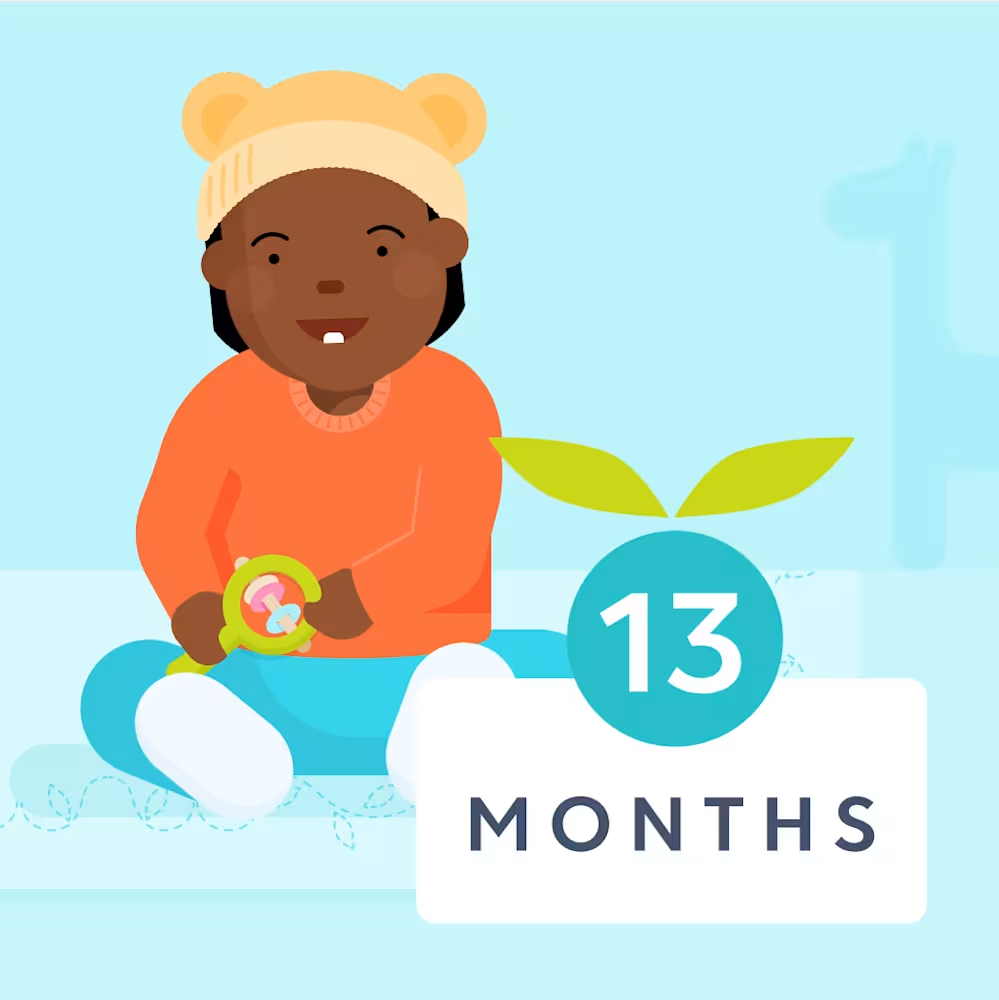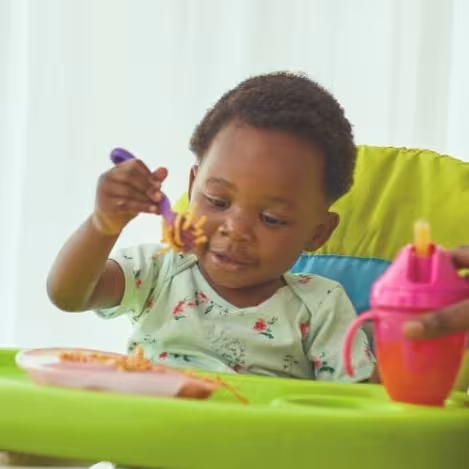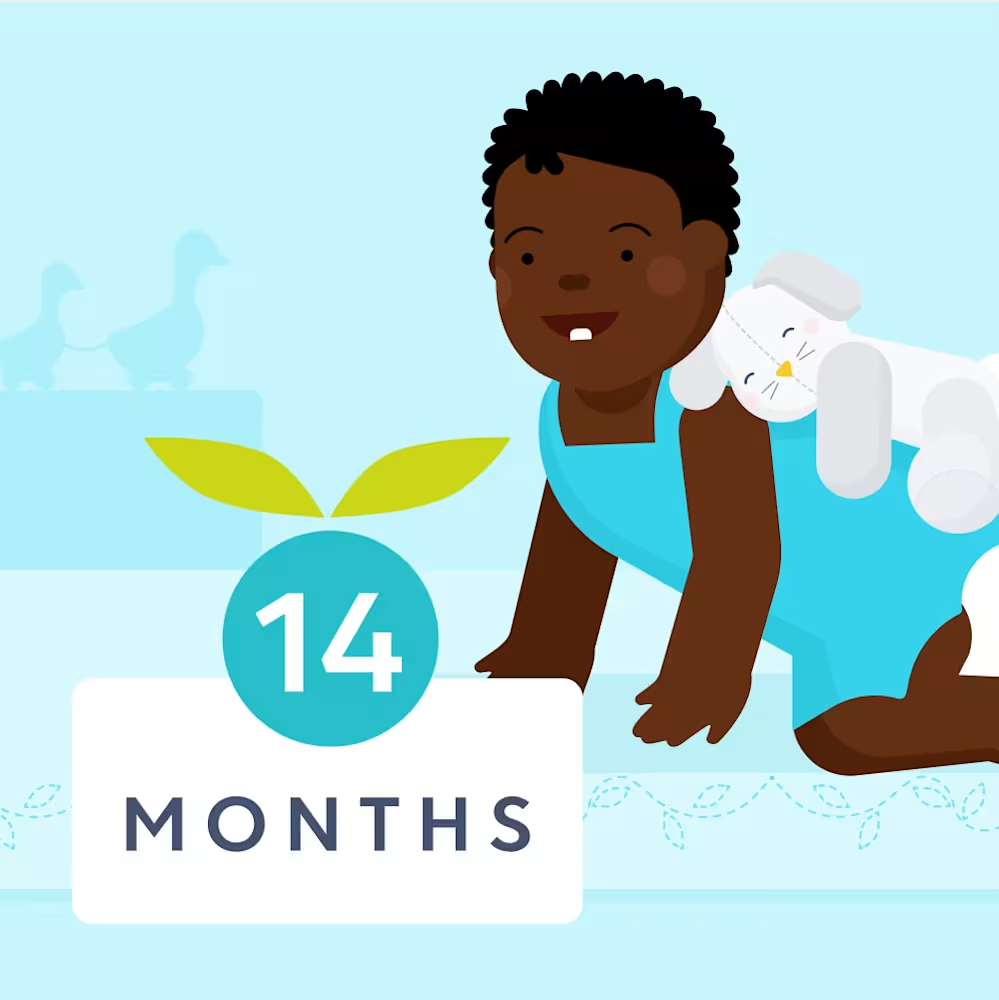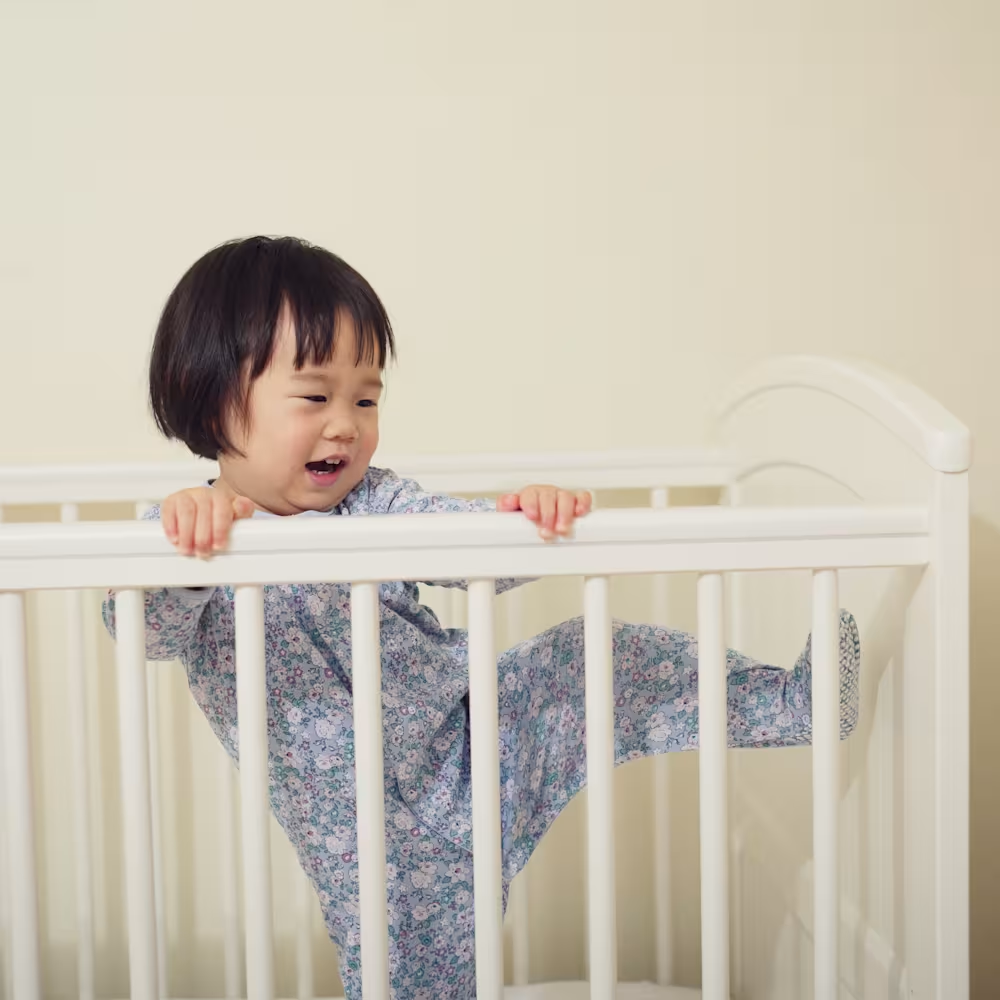13 month sleep regression: Myth or real?
Updated Dec 02, 2025

Now that your child has celebrated their first birthday, you may be eager to put any previous sleep challenges behind you. Unfortunately, it’s not uncommon for toddlers to continue experiencing ups and downs when it comes to sleep in their second year. However, this isn’t the case for every child and there’s no predetermined “13 month sleep regression” lurking in the shadows. Sleep bumps can happen at any age!
In this article, we’ll guide you through how to help your child get the rest they need, answer frequently asked questions about sleep at 13 months, and give you insight into common toddler sleep challenges.
Table of Contents
Is there a 13 month old sleep regression?
If your 13 month old had been sleeping through the night and began calling out at nighttime again or taking short naps, we’d consider that a sleep regression. We define a sleep regression as a sudden, significant decline in sleep patterns.
It’s not uncommon for children to experience sleep challenges following their first birthday. (We’ll take you through a few common reasons why below.) However, a “13 month sleep regression” isn’t something all children go through. Every kiddo is different and sleep regressions can happen at any age for various reasons, like travel, illness, developmental milestones, and life changes such as moving or starting a new daycare.
Why do 13 month old babies have sleep issues?
Reason #1: They’d prefer to work on milestones, not sleep
Toddlers at 13 months are often working on like walking, whether they’re cruising along sturdy furniture or taking independent steps. Walking is much more interesting than sleeping — at least for a while. It’s pretty typical for toddlers to resist sleep while mastering these exciting milestones.
Reason #2: They need more time between sleep periods
If your little one is suddenly fighting sleep or skipping naps, this may signal that they need longer wake windows. It’s likely they’re not tired enough to fall asleep at their usual nap times. At 13 months, toddlers often need of awake time before they’re ready to sleep again. However, all children are different and some may have higher or lower sleep needs.
While some children may be ready to at around 14 months, we find that 13 month olds often benefit from a 2-nap schedule. A 1-nap schedule requires a child to stay awake for 5+ hours at a time, which may lead to overtiredness. When toddlers get too tired, this often makes it harder for them to fall asleep and stay asleep. Most little ones are typically ready to drop their second nap between 14 - 18 months.
Reason #3: They’ve developed sleep onset associations
If a child is used to being fed, rocked, or otherwise helped to sleep, we call this a sleep onset association. Children typically rely on this support and protest if it’s taken away, which makes sense — it’s part of their sleep routine! Sleep onset associations may also lead to more sleep challenges [] like increased nighttime wakings between sleep cycles and less sleep overall.
Reason #4: They’re waking due to hunger
There may be an adjustment period sometime after your child’s first birthday when solid foods become their primary source of nutrition. If your child isn’t eating enough during the day, it’s common to see increased night waking, early waking, and/or short naps — sleeping on an empty stomach is tricky for adults too!
How long does a 13 month sleep regression last?
It would be so much easier if sleep regressions had definitive start and end dates! However, it doesn’t quite work that way. Instead, the length of a challenging sleep phase usually depends on what’s causing the disruption and how it's addressed.
For example, teething may suddenly disrupt sleep for a week before things return to “normal.” On the other hand, if you make a change to the way your little one falls asleep (e.g. you no longer feed them to sleep), it may take a longer time for them to adjust to receiving less help before bed.
My 13 month old won’t nap. Does 13 month regression affect naps?
Sleep regressions don’t only impact overnight sleep. If your 13 month old had been napping well then begins regularly resisting or skipping naps, some would consider this a “13 month nap regression.” One possible reason for nap challenges at 13 months is a child’s wake windows are too short before naptime. Consider a schedule adjustment to get their daytime sleep back on track. Try lengthening wake windows to 3.75 - 4 hours so it’s easier for them to fall asleep during the day.
If your 13 month old is struggling with daytime sleep, you may be tempted to transition them to a. However, we find that dropping a child’s afternoon nap too soon can lead to overtiredness, which usually makes it harder for toddlers to fall asleep and stay asleep. Most children are developmentally ready to switch to one nap between 14 - 18 months.
If your toddler is approaching 14 months and seems ready for a new schedule, note that it’s common for children to sometimes flip-flop between 2-nap and 1-nap days during a nap transition. They may be able to comfortably handle a few consecutive days with one nap before becoming overtired, which often leads to more sleep issues (and meltdowns!). If your schedule permits, try offering your toddler two naps every few days — or just on the weekends — to help “reset” the sleep pressure that builds up as they adjust to a new schedule.
4 tips to handle 13 month old sleep issues or regressions
Tip | Why it helps | What to try |
|---|---|---|
Promote practicing new skills during awake times. | Milestones like walking or talking can make it hard for toddlers to “switch off” at night. | Give your child plenty of daytime practice with new skills so bedtime feels like rest time, not playtime. Expect some temporary sleep challenges — they're normal! |
Reevaluate your 13 month old’s sleep schedule. | Keeping the right balance of naps and wake time helps prevent overtiredness. | Aim for about 13.25 hours total sleep (11 - 12 hours at night, 2 - 3 hours during the day). Try 3.25 - 4 hours awake between naps and 3.75 - 4 before bedtime. |
Move bedtime earlier if your toddler skips a nap. | An earlier bedtime helps offset lost daytime sleep and prevents overtiredness. | If a nap is skipped, offer bedtime 15 - 45 minutes earlier (no earlier than 6 PM). Watch for readiness signs before fully transitioning to one nap. |
Consider teaching your child to fall asleep independently. | Self-soothing skills help toddlers fall asleep faster and stay asleep longer. | Choose a sleep training method that fits your comfort level — from gentle to faster approaches. Need help? Try for a personalized Sleep Plan. |
Find more details below:
Tip #1: Promote practicing new skills during awake times
Walking and talking are so exciting to toddlers. Sleep? Not so much. Give your child lots of opportunities to practice their new skills during the day, that way they’re (maybe) more inclined to wind down to sleep at bedtime. Some lost sleep is likely inevitable during these big milestones and that’s normal. Once new skills are mastered, the hope is your little one will return to their typical sleep patterns.
Tip #2: Reevaluate your 13 month old’s sleep schedule
At this age, we expect around 13.25 hours of total sleep per day, which usually looks like 11 - 12 hours overnight and 2 - 3 hours of daytime sleep, split over 2 naps. Ideally, each nap is around 1 - 2 hours long. Most toddlers need around 3.25 - 4 hours of awake time between sleep periods at 13 months.
However, every child is different and some toddlers may have higher or lower sleep needs. If your child doesn’t seem tired at naptime and bedtime, they may require more awake time before sleep and that’s OK! Consider lengthening wake windows to 3.75 - 4 hours. This may result in only 10 hours of night sleep, which can be a better option than dropping the nap too early. Typically, toddlers should be able to comfortably stay awake for 5 hours or longer before switching to a 1-nap schedule. Most children drop their second nap between 14 - 18 months.
In general, we recommend paying attention to your child’s overall mood and energy levels when evaluating if they’re getting enough sleep.
Tip #3: Move bedtime earlier if your toddler skips a nap
Skipped naps happen! If your little one has opted not to nap on a particular day, we suggest offering an earlier bedtime (but not before 6:00 PM) to limit overtiredness. If your child regularly skips naps (especially their second one of the day), this may be a sign that they’re ready for a. However, we caution that switching to a 1-nap schedule prematurely often leads to overtiredness, which presents its own set of sleep challenges. They may just need longer wake windows with the 2-nap schedule instead.
Tip #4: Consider teaching your child to fall asleep independently
There are various you can implement to teach your child to self-soothe and fall asleep without your support. Some are more gradual and “gentle,” while others tend to be quicker and may involve more short-term crying.
If you’re feeling stuck, we can help! With you can submit for a personalized, step-by-step Sleep Plan for your child.
How much sleep does a 13 month old need?
, most toddlers need about 13.25 hours of total sleep across a 24-hour period. This often breaks down into 11 - 12 hours overnight, plus around 2 - 3 hours during the day. However, sleep needs vary and there’s a range of normal. Daytime sleep is often split between two naps. However, some toddlers may resist the afternoon nap at this age. We recommend continuing to offer two naps at 13 months to avoid overtiredness that can contribute to sleep challenges. Most kiddos transition to a one-nap schedule between 14 - 18 months.
If your child is sleeping a little more or less than these guidelines but seems well-rested and happy, that’s OK too. Keep an eye on their mood, energy levels, and how they handle wake windows to gauge if they’re getting the rest they need.
How can I tell if it's separation anxiety or 13 month sleep problems?
At 13 months, separation anxiety may still be a factor, though many toddlers are starting to manage it better. As your child becomes more mobile and independent, they’re also gaining a better understanding that when you leave, you’ll return. Continued practice with short separations — like daycare drop-offs or brief errands — can help reinforce that absence is temporary.
Still, you may notice clinginess, fussiness, or bedtime resistance. Offer reassurance, maintain predictable routines, and remember this phase is a normal part of emotional development. Though frustrating at times, it's a sign that you and your child are bonded. That's a good thing!
How can I tell if it's teething or 13 month sleep problems?
Teething can still affect sleep around 13 months, so it's not so much teething or sleep problems. Instead, teething can contribute to new sleep challenges. At this age, your little one may be cutting molars, which can lead to soreness, fussiness, and extra nighttime wake ups. Fortunately, teething discomfort usually passes fairly quickly.
Teething can sometimes trigger temporary sleep disruptions, but with comfort and consistency, sleep usually goes back to normal once the discomfort passes. Offer extra cuddles when needed, but try to stick to your usual bedtime routines to help your child get the rest they need.
Can you sleep train during a sleep regression?
Yes, is still an option during a regression at 13 months. Whether you opt for a gradual method like fading or a more direct approach like the Ferber method, consistency is key. Remember every child is different, and the “best” sleep training method is the one that aligns with your baby’s temperament and your parenting style.
Can I let my 13 month old cry it out during a sleep regression?
By 13 months, many toddlers are developmentally able to handle sleep training, even during a rough patch like a regression. If you’re considering a “” (CIO) or extinction method, know that it’s one of several approaches to choose from. CIO may be effective for some families, especially if check-ins tend to escalate crying. If you go this route, make sure your child is fed, dry, and safe before putting them down. Also consider monitoring with a video baby monitor. Prefer another option? Techniques like timed check-ins or gradual withdrawal can also teach self-soothing skills while offering some support along the way. Whatever method you go with, trust your instincts and adjust as needed. Check in with your child’s pediatrician before getting started.
What are self-care tips for tired parents?
Wake up with water: Looking to boost your mood in the morning after a long night? Try a cool or lukewarm shower to wake up your senses, clear your head, and get your energy going. Add in your favorite song and body wash too.
Take 10 for yourself: Do you find yourself wishing you could just take a break? Though a tropical vacation would be nice, sometimes even a mini break each day can offer a little relief from the chaos of the day. Try to build in a 10-minute chunk of “me time” each day if possible where you can listen to your favorite podcast, drink your coffee while it’s hot, or even get in a few minutes of the show you’ve been meaning to watch.
Practice deep breathing: You may encourage your little one to take deep breaths and they can actually help shift your stress response too! Try inhaling for 4 counts, holding for 5, then exhaling for 6. Repeat a few times as needed to help reset your nervous system.
Should I let my baby sleep in my bed during a regression?
The American Academy of Pediatrics (AAP) advises against bedsharing during a baby’s first year to help reduce the risk of SIDS []. After 12 months, that guidance becomes less specific. While the AAP still doesn’t formally endorse bedsharing, the risk of SIDS drops by this age. That said, it’s still important to be mindful of other safety concerns like falls, suffocation, and entrapment.
Many families do choose to bedshare at this age, especially if it helps everyone get a little more sleep during tough phases like regressions. If you choose to bring your little one into bed, try to keep things as safe as possible: use a firm mattress, keep pillows and heavy blankets away from your child, and avoid sharing the bed with anyone under the influence of substances that affect alertness.
When to talk to a doctor
It’s normal for sleep to fluctuate during toddlerhood — teething, growth spurts, and/or newfound mobility can all impact rest. But if something feels off, you know your baby best. Reach out to your pediatrician if:
Feeding or weight gain concerns arise, like skipping meals frequently or not gaining as expected (though it’s normal for growth to slow down in your baby’s second year).
Persistent fussiness or signs of pain seem unusual or harder to soothe.
Unusual symptoms appear, like fever, rash, vomiting, or a lingering cough.
Your child sleeps significantly more than usual or seems unusually difficult to wake up.
You have a gut feeling that something isn’t right. Always trust your instincts — it’s often better to err on the side of caution when it comes to your child’s well-being..
Takeaway
Sleep regressions can happen at any age and don’t have predetermined start and end dates. Toddlers around 13 months often go through periods of poor sleep for various reasons, including wanting to work on milestones, needing a sleep schedule adjustment, and/or falling asleep with support.
Daytime sleep is often impacted during sleep regressions. Consider lengthening the time your child is awake between sleep periods if they don’t seem tired at naptimes and may need more awake time.
It may be tempting to switch your child to a 1-nap schedule if they’re struggling with daytime sleep and skipping naps. However, dropping the afternoon nap prematurely often leads to overtiredness, which may make it harder for your toddler to fall asleep and stay asleep. Most children are ready to move to 1 daily nap between 14 - 18 months.
13 month sleep regression FAQ
Share article:
Note: The content on this site is for informational purposes only and should not replace medical advice from your doctor, pediatrician, or medical professional. If you have questions or concerns, you should contact a medical professional.
3 Sources
Table of Contents
Share article:





